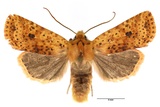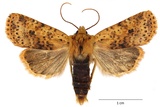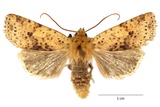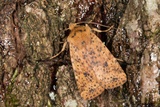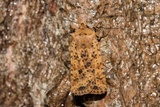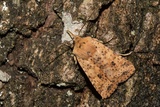Conistra rubiginea ([Denis & Schiffermüller], 1775) Species
Last modified: Nov. 19, 2025, 4:31 p.m.
A not so common species throughout Belgium.
This species is considered Least Concern according to the IUCN Red List category for Flanders 2023.
Details
- Classification
- Family: Noctuidae > Subfamily: Xyleninae > Tribus: Xylenini > Genus: Conistra > Subgenus: Dasycampa > Species: Conistra rubiginea
- Vernacular names
- Gevlekte winteruil (NL), Dotted Chestnut (EN), L'Orrhodie tigrée (FR), Rost-Wintereule (DE)
- First mention in Belgium
- De Sélys-Longchamps E. 1857a. Catalogue des Insectes Lépidoptères de la Belgique. — Annales de la Société entomologique belge 1: 1–111. On page 176 (as Dasycampa Rubiginea, W. V.). view page
- Status
-
Native
Distribution
Case
The pupal stage lasts 2-3 weeks.
Bionomics
Egg stage is about 14-17 days and the caterpillar stage is over six weeks. The caterpillars show cannibalistic behavior from the penultimate instar and eat their own kind. The mature caterpillars
make a sturdy cocoon in the litter layer (In the literature, it is reported that the caterpillars use ant nests to pupate).
Hibernates as an adult. They come to light and sugar.
Flight periods
The adults fly from early October onwards, and after hibernation, back again till late April in one generation.
Observed on
- Host plant (species):
- Prunus spinosa
- Host plant (genera):
- Malus, Taraxacum and Salix
- Substrates:
- Deciduous trees and Herbaceous plants
The larva lives first on various species of deciduous trees like Malus, Prunus spinosa or Salix. Later on various species of herbaceous plants like Taraxacum.
